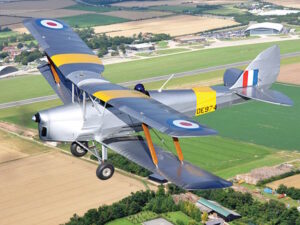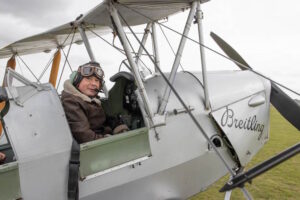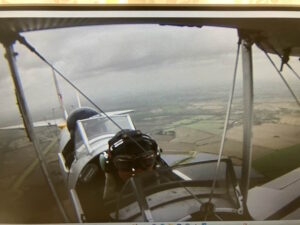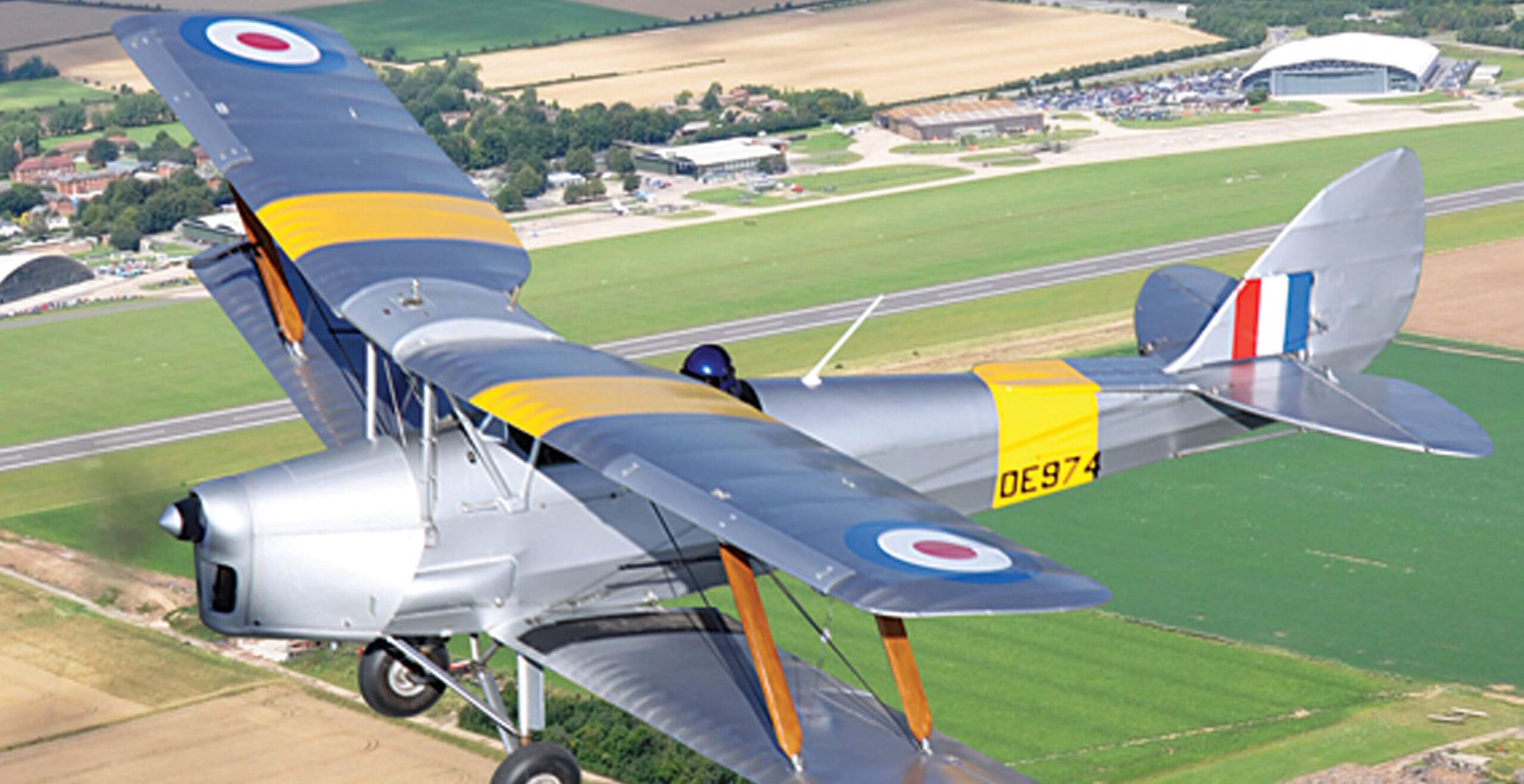Cambridge Tiger
It is rare today in the aviation world to fly in an open cockpit. Why would anyone want to, when modern commercial and light aircraft are exemplars of enclosed sophistication, speed, power and comfort? This is why.
To fly unenclosed is a thrilling experience which will transport you back to the 1930s in an instant.
In Britain, this was an epic decade for flying, with bustling aero clubs, air racing, record breaking aviators and aviatrixes and pleasure flights affordable to the general public for the first time. Open cockpit piston-engine biplane aircraft had captured the popular British imagination and were all the rage. Wealthy individuals were purchasing their own machines from a vast stockpile of military airframes and engines left over from the First World War (1914-1918). The innovative biplane designs of contemporary entrepreneurs such as Geoffrey De Havilland (1882-1965), an air manufacturing genius who secured large commercial and government contracts in this period, were revolutionising the marketplace. De Havilland’s efficient and hugely popular civilian aircraft, such as the DH 60 Gipsy Moth (1928) and DH 80 Puss Moth (1930) were world leading, at home and for lucrative export.
In the early 1930s military pilots also learnt to fly in open cockpits. In Britain, Royal Air Force (RAF) pilots received their ‘ab initio’ (primary) flight training at the RAF’s Central Flying School, Upavon, Wiltshire and at other aerodromes dotted across the country. They were about to experience an iconic aircraft.

In 1931, De Havilland began production of a new military trainer for the RAF, the world-famous, dual control DH 82 Tiger Moth. 24 feet long with a 29.4-foot wingspan, and weighing around 1,825 lbs, the new steel framed, wood and fabric biplanes were powered by a De Havilland air-cooled, four-cylinder Gipsy Major piston engine, generating around 130-hp (97kW). They could reach airspeeds of around 85-100 mph, with take-off and landing speeds of around 40 mph. They had a range of some 300 miles (on a 19-gallon fuel tank mounted on the upper wing above the front seat). The RAF required modification of the cockpit seats, to enable instructors and trainees to wear parachutes to bail out if necessary. With room for an instructor in the front seat and pupil in rear – both wearing parachutes – it was ideal for basic flight training. It entered service with the RAF in 1932. The Tiger Moth was manufactured at Hatfield, Hertfordshire and by Morris Motors Limited at Cowley, Oxfordshire (from 1941). 8,800 were built up to 1944 and saw military service until 1952. Of these, 4,000 were produced in Britain. Others were manufactured in Canada, Australia, New Zealand, Portugal, and Sweden. By 1939, 1,378 aircraft were operational.
The Tiger Moth was, and is, an aircraft with real history. It grips the imagination. It evokes the 1930s powerfully, not merely for the excellence of its design but because it prepared so many British and Commonwealth RAF pilots for war, when national survival was at stake. When the Second World War (1939-1945) broke out, there was a price to pay. During the Battle of Britain alone (July to October 1940), 544 British and allied fighter pilots were killed. RAF Bomber Command also suffered 55,573 British and Commonwealth aircrew killed during the war. Many had first trained in Tiger Moths.
Ab Initio
In Britain, open cockpit flying in period aircraft remains accessible and affordable. My air experience flight in a DH 82 Tiger Moth, for half an hour on a September afternoon, took off from Duxford Airfield, seven miles south of Cambridge. Aircrew of both the Royal Flying Corps (1912-18) and its successor the Royal Air Force (RAF) trained in biplanes there from 1917-1924 and during the 1930s. Students from the Cambridge University Air Squadron (CUAS) also trained on Tiger Moths at Duxford during 1932-1939. During the Second World War, Duxford was both an RAF and USAAF (United States Army Air Force) operational fighter station, bombed by the Luftwaffe during the Battle of Britain in 1940. Today, Duxford is home to the Imperial War Museum’s (IWM) aircraft collections and its hugely popular summer air shows. Private operators based at Duxford also offer daily vintage aircraft flights.
In my case, I had flown in a De Havilland aircraft before, in a 1950s DHC-1 Chipmunk trainer, in my school CCF (Combined Cadet Force). But that was back in 1979 and I had never experienced open cockpit flying.

Wonderfully, I was issued on arrival with a 1930s-style flying jacket, leather flying helmet and goggles, as well as an aviation headphone set and microphone to communicate with the pilot in the rear seat behind me. The Tiger Moth was waiting, expectantly. Built during the Second World War by Morris Motors at Cowley, it gleamed in period silver and yellow training colours with RAF roundels on the fuselage and upper and lower wings. I clambered into the front seat from the right side, using the black strip on the right wing and wooden struts between for leverage. Advised to avoid the compact fuel tank just above my head on the upper wing, I fastened leg and shoulder straps, and connected the headphones. I positioned myself away from the dual flight controls. It was a tight fit but in no way uncomfortable. The two cockpit side hatches were closed around me. Soon I heard the magical words exchanged on the headset between pilot and groundcrew: “Throttle Set, Contact”. The pilot switched on the magneto system; the Gipsy Major engine sprang to life. The black six-foot long propeller began to spin rapidly, just in front of me. Sitting in that open cockpit, as the engine warmed up, watching the engine revolutions per minute (RPM) increase on the panel instrument, I felt the wood and fabric airframe vibrating purposefully. It was a transport of delight into the past.
Air experience
At Duxford you are flying in the slipstream of legendary aircraft and in historical crosswinds. An American P-51 Mustang fighter taxied past and took off close by. The twin engines of a Second World War Consolidated Catalina – a rare airworthy example – were also revving up. A Supermarine Spitfire and North American Harvard trainer were parked languidly nearby. Over the headset I heard the Control Tower clear us for take-off. I expected to taxi leisurely onto a hard runway, but the Tiger Moth was not hanging around. It moved purposefully straight across the grass airfield and took off smartly, as so many trainee RAF pilots in the 1930s had done before.
It was an overcast autumnal day. A milky sun peered at us through the grey clouds ahead, just above the arc of the spinning propeller. We climbed gradually to around 1,800 feet, under the cloud base, and flew west from Duxford, following a circuit of around 8 miles and back over the town of Royston, Hertfordshire. Our airspeed reached around 90 mph.
The sensation of flying in a biplane’s open cockpit is like nothing else. It was truly extraordinary. I felt connected to the fuselage. What struck me first was the sound, the whistling rush of air through the wooden struts and wires supporting both wings. The engine droned attractively, the ailerons on the lower wings moved slightly as the biplane banked. The skill of the pilot ensured it was a smooth flight that afternoon, with little of the strong wind buffeting I had expected. The Cambridgeshire and Hertfordshire fields and houses drifted sedately past below us. It was not cold at that altitude; the flying jacket was sufficient. The transparent wind screen in front largely deflected the air flow. There was no need to fasten the goggles provided but I could not resist it. I leant to the left and right in the open cockpit and the wind promptly made itself felt. It was interesting to see the dual control column and the rudder pedals moving deftly as the pilot behind manoeuvred. The on-off engine throttle lever to my left, periodically closed and opened.
The pilot banked the Tiger Moth – sharply and thrillingly- over the old RAF Bassingbourn airfield, north of Royston. Opened in 1938, it also served as an operational RAF and USAAF station during the Second World War. Allied bombers headed out in streams from Bassingbourn on operations over Germany. The old runways and dispersal areas were clearly visible. The airfield closed in 1969 but its barracks remains a British Army training base. Looking north, I saw the impressive green tree lined avenue leading up the 17th century Wimpole Hall and Estate.

Then came the best part. The pilot allowed me to take the controls. He advised me to grip the control column, between thumb and forefinger, rather than by a closed fist: the controls were sensitive. ‘You have control’, he intoned. ‘I have control’, I replied. For a few minutes I managed to bank, climb and pitch forward in a dive, briefly. It was exhilarating. The Tiger Moth responded to a light touch, but you could feel the power. The wind whistled. The milky sun ahead seemed to regard me, curiously. ‘Nicely done’, said the pilot, generously, before taking back control. I recalled a visit to the Duxford Museum 20 years before, with my father. Then, we had watched a Tiger Moth take off. ‘One day I’ll do that’, I remembered telling him.
On the return approach eastwards, I was impressed to see the Duxford airfield from the air, under leaden skies, and to reflect on its searing and distinguished history as a front-line station during the Second World War. I imagined the RAF trainees put through their paces by instructors back in the 1930s, before heading back to their Mess and classrooms. The pilot made a soft landing on the grass with consummate skill – the vintage Tiger Moth has a sprung tailskid, not a tail wheel, and no brakes – and we taxied back to the flight office. As I climbed out of the open cockpit to shake the pilot’s hand, I had a broad smile on my face. The sound of that whistling wind stayed with me for hours. Enticed by the prospect, I was not disappointed. I will not forget that flight in a hurry. If you want to experience flying the old way, there is nothing to top the marvel that is De Havilland’s DH 82 Tiger Moth.
By Ronan Thomas.
